Adonis legend
Adon (Lord in Semitic), was known by the Babylonians under the name of Tammuz, or Adonis among the Greeks and Romans. He represented the young god in the religious triad of Jbeil (Byblos) and Baalbek. He was worshiped in other Phoenician cities although known with other names: He was Echmoun for Sidonians or Melkart in Tyre ... He was the equivalent of Osiris among the Egyptians...
His legend was communicated by many historians and travelers. It was differently adapted in each country dependant on each civilization.
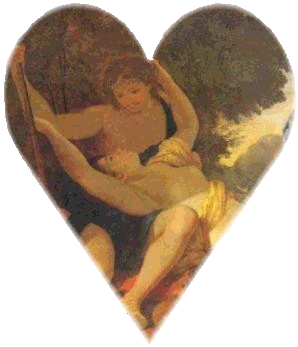
Adonis & Astarte
The translation of some Phoenician writings suggests that Adon is the son of the god El and his wife the goddess Asherah, who had taken the form of a tree. Another inscription found in Cyprus, relates the story of a god, which could be Adon, who was born following a royal incest relationship in the island. Amongst the Carthaginians, Adon is the son of Phoenix and the nymph Alphesiboeus. In Greek mythology we find several similar versions of this legend, where only the actors change.
However, most of those stories agree upon the fact that Adon (Adonis) was born of an incestuous relationship between a king of the eastern Mediterranean and his daughter. A version talks about Cinyras king of Assyria and his daughter Smyrna. Another version mentions the king of Cyprus Theias and his daughter Myrrha…
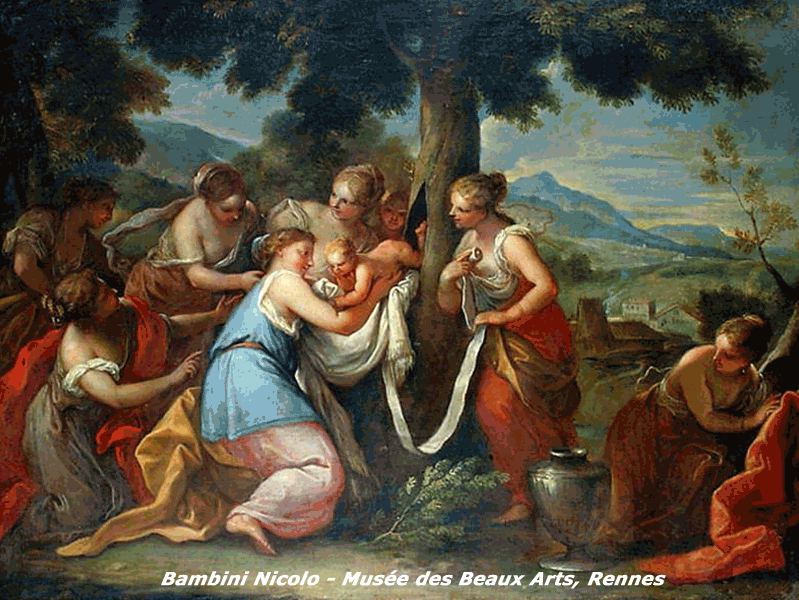
Birth of Adonis
Myrrha was known for her beauty which surpassed that of Astarte (Aphrodite to the Greeks and Venus to the Romans). The goddess, out of jealousy, inspired Myrrha to fall in love with her father. With the assistance of Hippolytus her nurse, Myrrha managed to sleep with her father without hem knowing it was his daughter, and she got pregnant. The king, discovering the truth, took out his sword and went looking for his daughter to kill her. Myrrha taken by fear and shame, begged the gods to protect her. They answered and transformed her into a tree (known as the Myrrh - balsam). Nine months later, the tree split in two and Adon was born.
According to Greek mythology, Aphrodite, attracted by the beauty of the newborn, hid him in a box that she confided to Persephone, the queen of the underworld. Driven by curiosity, Persephone opened the box and found Adonis, spell-bound by his enchanting beauty, she brought him out and raised him in her palace. Adonis became a very handsome young man, Persephone fell in love with him. Aphrodite, coming back to the underworld to reclaim Adonis, was confronted by the queen who refused to let him go. Zeus intervened and decided to divide the year into three parts. Adonis had to spend the first four months with Persephone, the second four with Aphrodite, and the last four to do whatever he wants. Adonis executed this judgment, nonetheless he decided to devote his free time to Aphrodite.
Adonis loved hunting, he spent most of his time pursuing his passion around Byblos. Aphrodite, madly in love with this young man, followed him in all these tours. One day he was hunting in a location called Afqa, when he came across a wild boar and fought it, and the boar bit him in his leg. Aphrodite rushed beside her lover and attempted to save him. Adonis succumbed to his injuries, and his blood was spread on the ground giving birth to anemones, and thereafter was mixed with the nearby river and the water became red, and since then, the river is known as "Nahr Adonis". Thereafter the goddess celebrated her lover's death every spring by organizing large parties.
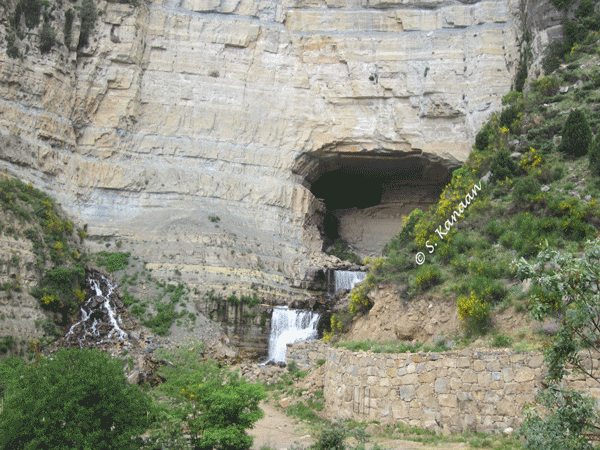
Cave of Afqa
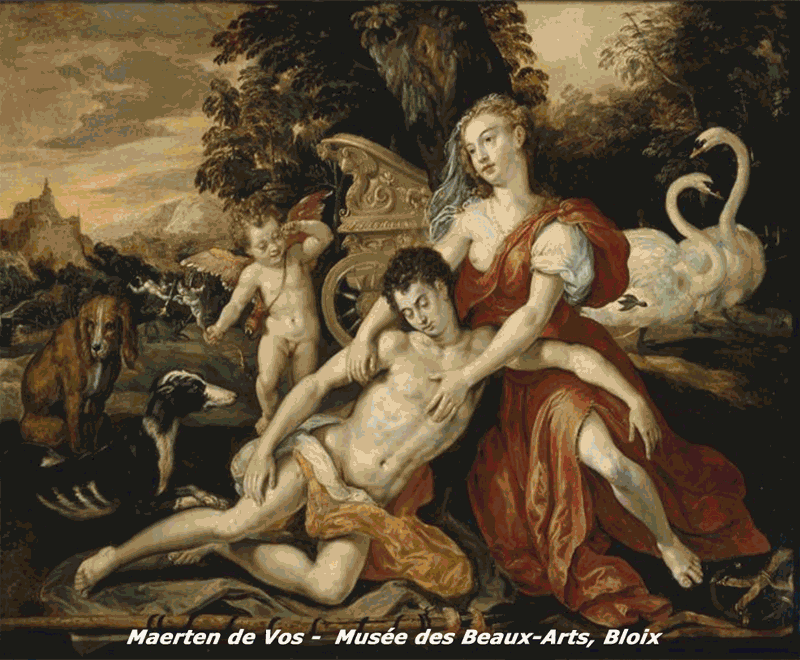
Death of Adonis
This death could have been an unfortunate hunting accident, but there were various other versions. Some stories relate that Ares, god of war and the lover of Aphrodite, has metamorphosed into a Wild boar, and attacked Adonis because of jealousy. Others assert that it was Apollon who killed Adonis, in revenge for Aphrodite's: "Erymanthos, son of Apollon, was punished because he had seen Aphrodite after her union with Adonis and Apollon, irritated, changed himself into a wild boar and killed Adonis by striking through his defenses." (Quote attributed to Ptolemy Hephaestion by Photios in 'New History', book 1). Another interpretation relates that it was Persephone who was jealous that Adonis preferred to spend more time with her rival. Another version assumes that the goddess Aphrodite caused the accident herself, wanting to persuade her lover to abandon this dangerous activity.
Adonis was also known among the Romans, who changed the name of Astarte (Aphrodite) to Venus, and Persephone to Proserpine. Jupiter replaced Zeus, and Ares became Mars. The Roman legend tells that Adonis, at his birth, was raised by nymphs in Mount Lebanon caves, near the source of a river which today is known under the name of "Nahr Ibrahim". Adonis grew up to be a handsome man who loved hunting, and spent his time in the forests near Byblos. One day Venus saw him, succumbed to his charm and fell in love with him. The story of his death is identical to the Greek version with some nuances. Among the Romans, Diane, goddess of hunting, had intentionally placed this boar in Adonis's way, to avenge the death of Hippolytus caused by Venus. Another variation recounts the metamorphosis of the god Mars into a boar to eliminate his rival.
Adonis went down into the kingdom of the dead. Persephone, queen of hell, saw him and fell in love with this handsome man. Venus afflicted with this death, wanted to give a new life to her lover, and was offended by the refusal of Proserpine to let go of Adonis. Venus went to ask the intervention of Jupiter who finally decreed that Adonis should spend four months beside Proserpine, four with Venus and the rest of the free time of his choice. Adonis decided to spend this period with Venus. This breakdown cannot fail to remind us of the different periods of the year. Four months in the underworld, correspond to bad weather's period and the rest of nature's rebirth.
As you have certainly noticed, the legend of Adonis has traveled all around the ancient world and was adapted in each civilization. The stories though divergent, always agree on his legendary beauty, his relationship with the goddess of love, and his symbol of rebirth of nature. To his worship was affected some ancient festivals whose "Adonia" that were the most famous in Phoenicia, Greece, among the Romans and the Carthaginians. Several historians recounted these traditions and they have left diverse testimonies. We will transcribe some of them, particularly those that were taking place around Byblos.
During a visit, in the second century AD, to the sanctuaries of Sidon, and those of Byblos and specifically that of Afqa (the source of Nahr Ibrahim), Lucian of Samosata(1) tried to elucidate the origin of the cult of Adonis.
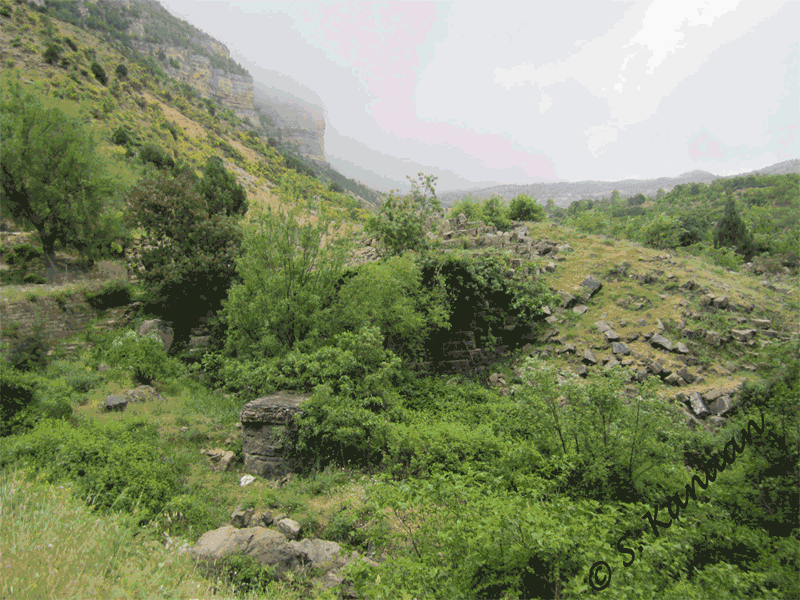
Remains of the temple
I also saw, in Byblos a great sanctuary of Aphrodite of Byblos in which they perform the rite of Adonis, and I made myself acquainted with this rite. They therefore say that what the boar did to Adonis occurred in their country. And in memory of this event and his suffering, each year they would smiting themselves, mourn, and celebrate the rites. Throughout the land they performed solemn lamentations.
When they ceased their breast-beating and weeping, first they would celebrate the funeral of Adonis as if he were dead, then the next day they would proclaim that he lives and send him to heaven, and finally they would shave their heads, like the Egyptians after the death of Apis. As for women who refuse to shave their heads, the following duties were enforced on them: For a whole day, they had to offer their beauty for sale. The place where they performed, was accessible only to foreigners, and the payment was considered as an offering to Aphrodite.
There is also another marvel in the land of Byblos. A river from Mount Lebanon empties into the sea. Adonis is the name given to the river. Each year the river becomes blood red and, having changed its color, flows into the sea and reddens a considerable part of the broad, giving a signal to the inhabitants of Byblos to begin the mourning and the lamentations. They recount the story that during these days Adonis has been wounded up on Mount Lebanon and his blood, by reaching the water, alters the river and gives to the stream the nickname that it has. This is the version that is most narrated, but an inhabitant of Byblos, who seemed to me to tell the truth, recounted another explanation for this phenomenon.
This is what he said:
"The River Adonis, stranger, passes through the Lebanon, where the land has an extremely reddish soil. Then strong winds come up on these days and transport the earth, which is quite red vermillion, into the river, and the soil makes the water blood red. So the cause of this phenomenon is not the blood, as people say, but it is the ground."
This is the explanation given to me by the man of Byblos. But even if his version is more plausible, I consider this coincidence with the intervention of the wind is somewhat divine.
Bishop Eusebius of Caesarea (260-340), in his "Church History"(2), speaks again about the presence of a temple dedicated to Astarte and Adonis, in the locality of Afqa near Byblos: "And as the keen-sighted eagle in its heavenward flight is able to descry from its lofty height the most distant objects on the earth, so did he, while residing in the imperial palace of his own fair city, discover as from a watch-tower a hidden and fatal snare of souls in the province of Phoenicia. This was a grove and temple, not situated in the midst of any city, nor in any public place, as for splendor of effect is generally the case, but apart from the beaten and frequented road, at Aphaca, on part of the summit of Mount Lebanon, and dedicated to the foul demon known by the name of Venus. It was a school of wickedness for all the votaries of impurity, and such as destroyed their bodies with effeminacy."
Ammianus Marcellinus (330-395), an ancient historian, recounted in his work Res gestae(3), the Adonia, "The women for their part, woefully beating their breasts and weeping after their wonted manner, loudly bewailed the hope of their nation cut off in the bloom of youth, just as the priestesses of Venus are often seen to weep at the annual festival of Adonis, which, as the mystic lore of religion tells us, is a kind of symbol of the ripened grain".
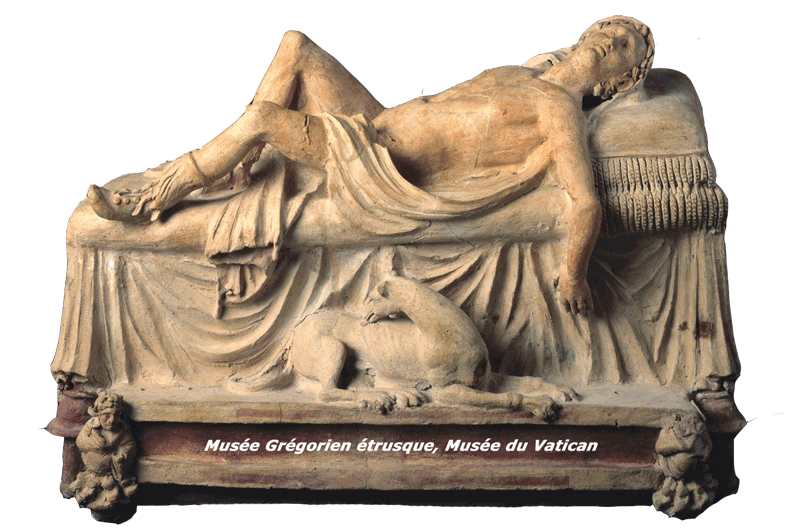
Adonis and the boar
The historian Sozomen (Salminius Hermias Sozomenus: 375-450), in his Ecclesiastical History (Book II)(4), speaks of the destruction of the temples, ordered by the Emperor Constantine (272-337) to reduce the practiced pagan worship still in some pilgrimage centers. "The temple of Aesculapius in Aegis, a city of Cilicia, and that of Venus at Aphaca, near Mount Lebanon and the river Adonis, were uprooted from their foundations. Both of these temples were most highly honored and reverenced by the ancients; in the former, it was said, the demon manifested himself by night, and healed the diseases of the sick. And at Aphaca, it was believed that on a certain prayer being uttered on a given day, a fire like a star descended from the top of Lebanon, and sunk into the neighboring river; this phenomenon they sometimes called Urania, and sometimes Venus."
Zosimus (5th century), Greek historian, reported the presence of a temple in Afqa (near Byblos): "At Aphaca, between Heliopolis and Byblos, there is a temple to Aphrodite Aphacitis, near which is a pond like an artificial tank. By the temple and in its environs, a fire like a lamp or a sphere burns in the air when people assemble here at certain times, as used to happen quite recently."(5)
| (1) |
Lucien de Samosate, De Dea Syria, traduction de Mario Meunier, Janick, Paris, 1947. |
Retour texte |
| (2) |
Mentionné par Edward Lipinski, Dieux et déesses de l’univers phénicien et punique, Peeters & Departement Oosterse Studies, Leuven 1995, p106. |
Retour texte |
| (3) |
Mentionné par Nina Jidejian, Byblos, à travers les âges, Dar el-Machreq Editeurs, Beyrouth, Liban, 1977, p.120. |
Retour texte |
| (4) |
Traduction par M. COUSIN, édition : Chez Damien Foucault, Imprimeur et Libraire ordinaire du ROI, Paris, 1686. |
Retour texte |
| (5) |
Mentionné par Brigitte Soyez, Byblos et la Fête des Adonies, Leiden E.J. BRILL, 1977, page 62. |
Retour texte |





